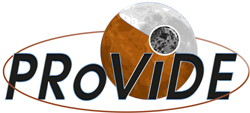It is widely recognised, [51] that most stereo methods provide a relatively coarse depth map which can be associated with a ‘low pass’ image of the depth map. In comparison SFS (shape from shading) derived DEMs (Digital Elevation Models) whilst exhibiting improved estimates of local surface areas can be associated with the ‘high pass’ image of the depth map (See Figure 13 for an example). It is therefore possible to integrate shape from stereo data with shape from shading data to produce a DEM whose fidelity is far greater that that obtained by one method alone.

Figure 13: Left image is the single 2D HRSC (High Resolution Stereo Camera) (H1022) image used as the input to the AU (Aberystwyth University) SFS (shape from shading) algorithm. The centre image is the 3D DEM (Digital Elevation Model) data generated by the SFS algorithm. The DEM has been reverse lighting rendered (as compared to the left input image) to demonstrate the 3D nature of the data. Note that the 3D DEM has not been rendered with the H1022 ortho-image. The right image is a topographic colour-coded image of the SFS generated DEM. Here the white coloured areas are the highest regions, and the dark blue coloured areas are the lowest regions.
Surface BRDFs (Bi-directional Reflectance Distribution Functions) are generated mainly from the available MER (Mars Exploration Rover) data in combination with orbital data where available. Image data are searched to identify those images that show surface regions surrounding the rovers where either 3D DTMs (Digital Terrain Models) have already been generated, or can be generated from MER (Mars Exploration Rover) PanCam (Panoramic Camera) stereo data, by using single image based shape from shading methods, or a combination of both [51]. AU (Aberystwyth University) supports this data search and where necessary, generates the associated DTMs (Digital Terrain Models).
Generating BRDF as additional product
Automatic BRDF (Bi-directional Reflectance Distribution Functions) generation from surface image products is a goal upon which PRoViDE (Planatary Robotics Vision Data Exploitation) is focused1. Using known radiometric calibration data from the MER (Mars Exploration Rover) PanCam (Panoramic Camera) cameras, Martian surface or rock regions in the selected image data can be identified and converted from pixel to radiance values, knowing the underlying 3D geometric structure for the identified pixel regions, camera to pixel region geometry, Sun azimuth and elevation, and known Sun irradiance values. Photometric stereo methods, for example, when applied to Mars typically assume a Lambertian reflectance model. This is a grossly simplistic model which is inaccurate for the majority of surface regions. To have BRDF models measured from real Martian surface data would make a significant contribution to those areas of planetary orbiter and surface science that require reflectance models as part of their results generation process. Orbiter science examples include: photometric stereo [56]; rendering of photogrammetric generated data [57], BRDF approaches to radiometric calibration for remote sensing studies [52]; surface composition [58]; surface roughness [61], and Mars atmospheric research [54]. Surface science examples include autonomous rock classification using BFH (Bidirectional Feature Histogram)/BRDF based techniques [50]; comparison of Martian surface BRDF data with terrestrial samples [55], and via this project, the creation of the first database of Martian surface measured BRDF data which we intend to submit to PDS (Planetary Data System).


